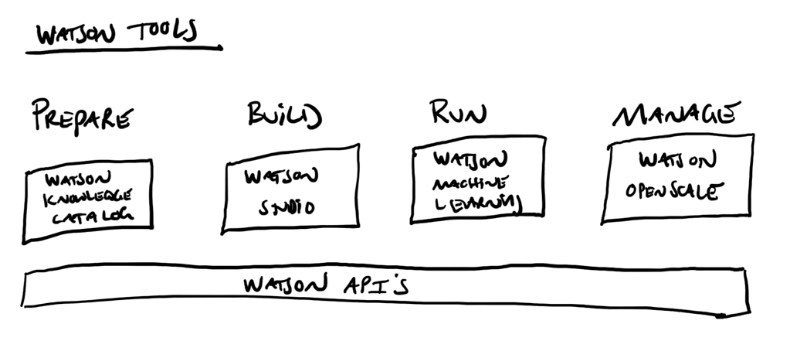This Is Watson
IBM Watson: Reflections and Projections
October 10, 2019 | Written by: Rob Thomas
Categorized: AI | Analytics | Data Science | IBM Watson | This Is Watson
Share this post:
 (Part 1 in a Series) AI has gone through many cycles since we first coined the term “machine learning” in 1959. Our latest resurgence began in 2011 when we put Watson on national television to play Jeopardy! against humans. This became a cornerstone event, demonstrating that we had something unique. And we saw early success, putting Watson to work on projects with clients. This created even more excitement. That excitement led to more opportunity. At this stage, we have a large product organization, separate dedicated research organization, and an entire health organization all leveraging and building on this technology.
(Part 1 in a Series) AI has gone through many cycles since we first coined the term “machine learning” in 1959. Our latest resurgence began in 2011 when we put Watson on national television to play Jeopardy! against humans. This became a cornerstone event, demonstrating that we had something unique. And we saw early success, putting Watson to work on projects with clients. This created even more excitement. That excitement led to more opportunity. At this stage, we have a large product organization, separate dedicated research organization, and an entire health organization all leveraging and building on this technology.
So, what is Watson? This is the question I’ve been asked the most since IBM combined its Data and AI software units earlier this year.
Let’s start with what it’s not. Watson is not a personal assistant like Alexa, Siri or Google Assistant – its capabilities far exceed those of a consumer AI device. However, consumers likely interact with some form of Watson every day, they just are not aware of it. That’s because Watson was built to enable business-to-business interactions. Watson technology spans everything from powering virtual assistants to embedding AI in business processes across many industries.
Watson does not have a voice, gender or personality. Many people associate Watson with the measured male voice used to bring it to life on Jeopardy! and in older TV commercials. We gave it a voice for those instances, but it is not a box that talks back to you. It is a set of composable microservices (software) that live in the cloud. Any cloud, public or private.
Put simply, Watson is software capable of making sense of data sets and understanding natural language to provide recommendations, make predictions, and automate work. As we have fine-tuned our approach, the “Watson” name is only used on IBM products and solutions that significantly utilize IBM Watson technology. For products and solutions in which AI is an embedded enhancement, we use the designation “with Watson.”
Watson Exists in Three Forms:
- Tools for companies that want to build their own AI
- Applications for companies that want to buy a pre-packaged AI solution
- Embedded machine learning and AI features
The tools for Watson include software that can be used for free, or, purchased/subscribed to when a company wants to use it more broadly. These tools help an organization collect data, organize data, build AI models, put AI models into production, and manage those models over time. Here’s a little-known fact: 85% of the work that happens inside these Watson tools is open source (Python, R, TensorFlow, etc.). After all, open source is the lingua franca of data and AI.
 If you want to see these tools for yourself, look for Watson Studio, Watson Machine Learning, Watson OpenScale, Watson Knowledge Catalog, and Watson APIs. I think you will like them. And, if you want something that you don’t see, just let us know.
If you want to see these tools for yourself, look for Watson Studio, Watson Machine Learning, Watson OpenScale, Watson Knowledge Catalog, and Watson APIs. I think you will like them. And, if you want something that you don’t see, just let us know.
The applications of Watson are prepackaged software that we built to solve a specific business problem. The leading application is Watson Assistant, for augmenting customer service agents. The Royal Bank of Scotland (RBS) is a great example of a company leveraging Watson Assistant.
Using Watson Assistant, they are now automating 40% of their inbound customer inquiries. With that automation, they shifted their customer service representatives to the hardest problems, increasing their customer satisfaction.
This is just one way AI gives humans superpowers. We have a few other applications: Watson Discovery, Planning Analytics with Watson, RegTech with Watson, Maximo with Watson, and we are working on something that will give every CIO in the world their own superpowers. More to come on that…
Watson is also embedded in a growing number of third-party solutions to give products and services AI superpowers. LegalMation is a great example of a company embedding Watson (in this case Watson Discovery) into its product, to help attorneys automate routine legal tasks and save thousands of hours of legal data discovery.
Ultimately, Watson – whether it’s the tools or the applications – can help companies save vast amounts of human hours and millions of dollars every year. And in other cases, it’s driving significant revenue increases. A recent story I love is about motorcycle maker, Harley Davidson, which is using Watson tools to build their own AI to find new potential motorcycle buyers.
But users beware: AI systems still must be trained. If you are expecting a magic black box, you will be disappointed. That said, we have some pretty interesting technology to accelerate/automate training times, which I’ll cover in the next two posts.
____________________________________________________________
NOTE: Over the next two weeks I will use this space to explain what it takes to win in AI, and what the future holds. I suspect this will elicit even more questions and discussion, which I welcome.

Senior Vice President, IBM Cloud and Data Platform
A New Wave: Transforming Our Understanding of Ocean Health
Humans have been plying the seas throughout history. But it wasn’t until the late 19th century that we began to truly study the ocean itself. An expedition in 1872 to 1876, by the Challenger, a converted Royal Navy gunship, traveled nearly 70,000 nautical miles and catalogued over 4,000 previously unknown species, building the foundations for modern […]
Igniting the Dynamic Workforce in Your Company
In the rapid push to moving to remote work, we’ve seen digital strategies accelerate by years – transforming their workplaces, workstyles, and business processes forever. Overnight, remote workforces put advanced environments of multi-device mobility, dynamic connection points and robust cloud-based apps that ease communication and collaboration. A new normal is emerging, led by the companies aggressively adopting cloud […]
Lessons from Space May Help Care for Those Living Through Social Isolation on Earth
Since the Crew Dragon spacecraft arrived at the International Space Station (ISS) on May 31, NASA astronauts Bob Behnken and Doug Hurley have been busy—according to their Twitter posts, even working over the weekend to repair the ISS treadmill. They likely don’t have much time to think about being lonely and cut off from life […]


